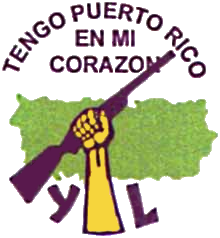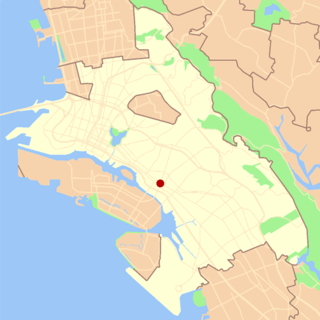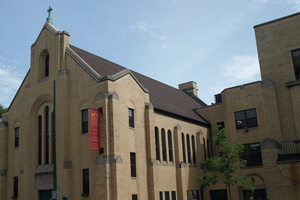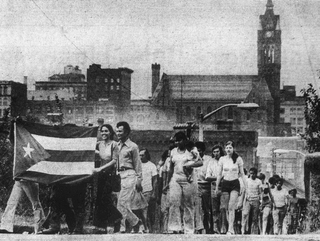Camden, New Jersey has long been home to Hispanic and Latino residents, and the Hispanic and Latino community has grown in size in the 21st century.
Camden, New Jersey has long been home to Hispanic and Latino residents, and the Hispanic and Latino community has grown in size in the 21st century.
Camden's 2010 census calculated 47% Hispanic citizens in the city and 15% in the county. [1]
One of the longest-standing traditions in Camden's Hispanic community is the San Juan Bautista Parade, a celebration of St. John the Baptist, conducted annually starting in 1957. The parade began in 1957 when a group of parishioners from Our Lady of Mount Carmel marched with the church founder Father Leonardo Carrieri. This march was originally a way for the parishioners to recognize and show their Puerto Rican Heritage, and eventually became the modern-day San Juan Bautista Parade. Since its conception, the parade has grown into the Parada San Juan Bautista, Inc, a non-for-profit organization dedicated to maintaining the community presence of Camden's Hispanic and Latino members. Some of the work that the Parada San Juan Bautista, Inc has done include a month long event for the parade with a community commemorative mass and a coronation pageant. The organization also awards up to $360,000 in scholarships to high school students of Puerto Rican descent. [2]
Puerto Rican Unity for Progress is a multi service, community based organization that is located in Camden and serves the Hispanic community who reside in the city. The organization was established in 1976 and opened its physical location at 437 Broadway Street in Camden in June 1978. The organization's mission states that "the agency offers assistance to Camden residents in the areas of housing, tenant-related matters, family planning, job placement, and educational counseling." In September 1977, Rutgers-Camden demoted the only Puerto Rican faculty member, Professor Ivette Puerta, who was the founder of the Graduate Program of Social Work. This demotion was protested by the Puerto Rican Unity for Progress. In 2012, Puerto Rican Unity for Progress acquired a grant from the New Jersey Department of Environmental protections to install a rain garden on their property. This garden treats and intercepts stormwater that otherwise would affect water quality in Camden. [3]
On December 31, 1987, the Latin American Economic Development Association (LAEDA). LAEDA is a non-profit economic development organization that helps with the creation of small business for minorities in Camden. LAEDA was founded under in an attempt to revitalize Camden's economy and provide job experience for its residents. LAEDA operates on a two major methods of rebuilding, The Entrepreneurial Development Training Program (EDTP) and the Neighborhood Commercial Expansion Initiative (NCEI). In 1990, LAEDA began a program called The Entrepreneurial Development Training Program (EDTP) which would offer residents employment and job opportunities through ownership of small businesses. The program over time created 506 businesses and 1,169 jobs. As of 2016, half of these businesses are still in operation. Neighborhood Commercial Expansion Initiative (NCEI) then finds locations for these business to operate in, purchasing and refurbishing abandoned real estate. As of 2016 four buildings have been refurbished including the First Camden National Bank & Trust Company Building. [4]
In 1995, the Concerned Leaders of Camden City and Camden County was formed by its executive director Roy Jones when learning that no blacks or Latinos were seen in Camden Hall. In his words, he wanted to bring representation in a white-centered government. He even envisioned more jobs for blacks and one head as Hispanic. [5] However, despite this, the council did not follow through with his demands until years later.
On May 30, 2000, Camden resident and grassroots organizer Lillian Santiago began a movement to rebuild abandoned lots in her North Camden neighborhood into playgrounds. The movement was met with resistance from the Camden government, citing monetary problems. As Santiago's movement gained more notability in her neighborhoods she was able to move other community members into action, including Reverend Heywood Wiggins. Wiggins was the president of the Camden Churches Organized for People, a coalition of 29 churches devoted to the improvement of Camden's communities, and with his support Santiago's movement succeeded. Santiago and Wiggins were also firm believers in Community Policing, which would result in their fight against Camden's corrupt police department and the eventual turnover to the state government.[ citation needed ]
Camden's Hispanic and Latino community is served by religious organizations such as Holy Name Church in North Camden. [6]
Some restaurants such as Old San Juan Restaurant and Freddy's Restaurant pay homage to the culture by having decorations and cooking traditional foods.[ citation needed ]

Antonia Pantoja, was a Puerto Rican educator, social worker, feminist, civil rights leader and the founder of ASPIRA, the Puerto Rican Forum, Boricua College and Producir. In 1996, she was the first Puerto Rican woman to receive the American Presidential Medal of Freedom.

The Nuyorican movement is a cultural and intellectual movement involving poets, writers, musicians and artists who are Puerto Rican or of Puerto Rican descent, who live in or near New York City, and either call themselves or are known as Nuyoricans. It originated in the late 1960s and early 1970s in neighborhoods such as Loisaida, East Harlem, Williamsburg, and the South Bronx as a means to validate Puerto Rican experience in the United States, particularly for poor and working-class people who suffered from marginalization, ostracism, and discrimination.

The Young Lords was a Chicago-based street gang that became a civil rights and human rights organization. The group, most active in the late 1960s and 1970s, aimed to fight for neighborhood empowerment and self-determination for Puerto Rico, Latino, and colonized people. Tactics used by the Young Lords include mass education, canvassing, community programs, occupations, and direct confrontation. The Young Lords became targets of the United States FBI's COINTELPRO program.

Juan González is an American progressive broadcast journalist and investigative reporter. He was also a columnist for the New York Daily News from 1987 to 2016. He frequently co-hosts the radio and television program Democracy Now! with Amy Goodman.

West Oakland is a neighborhood situated in the northwestern corner of Oakland, California, United States, situated west of Downtown Oakland, south of Emeryville, and north of Alameda. The neighborhood is located along the waterfront at the Port of Oakland and at the eastern end of the San Francisco–Oakland Bay Bridge. It lies at an elevation of 13 feet.

Fruitvale is a neighborhood in Oakland, California, United States. It is located approximately 4 miles (6.44 km) southeast of Downtown, and is home to the city's largest Hispanic community, with Hispanics constituting 53.8% of Fruitvale's population. Fruitvale's ZIP code is 94601. It lies at an elevation of 49 feet.

Fairhill is a neighborhood on the east side of the North Philadelphia section of Philadelphia, Pennsylvania, United States. Fairhill is bordered by Front Street to the east, Germantown Avenue to the west, Allegheny Avenue to the north, and Cumberland Street to the south. The neighborhood serves as the center of the Hispanic community of Philadelphia, and is known for its "El Centro de Oro" commercial strip along North 5th Street. Fairhill is adjacent to Harrowgate and West Kensington to the east, Hartranft to the south, Glenwood to the west, and Hunting Park to the north.

The first Puerto Ricans known to have migrated to New York City did so in the mid-1800s when Spain ruled Puerto Rico. Another wave of Puerto Ricans migrated to New York City after the Spanish–American War in 1898. Though no longer subjects of Spain, they were now citizens of an American possession and needed passports to travel to the contiguous United States.

At the 2010 census, there were 1,526,006 people, 590,071 households, and 352,272 families residing in the consolidated city-county of Philadelphia, Pennsylvania. The population density was 4,337.3 people/km2. There were 661,958 housing units at an average density of 1,891.9 units/km2.
The Division Street riots were episodes of rioting and civil unrest in Chicago which started on June 12 and continued through June 14, 1966. These riots are remembered as a turning point in Puerto Rican civic involvement in Chicago. This was the first riot in the United States attributed to Puerto Ricans.

Stateside Puerto Ricans, also ambiguously known as Puerto Rican Americans, or Puerto Ricans in the United States, are Puerto Ricans who are in the United States proper of the 50 states and the District of Columbia who were born in or trace any family ancestry to the unincorporated US territory of Puerto Rico.

WEMG is a commercial AM radio station licensed to serve Camden, New Jersey. The station is owned by Mega-Philadelphia, LLC, Debtor in Possession and airs a Spanish hits format.

Paseo Boricua is a section of Division Street in the Humboldt Park community of the West Side of Chicago, Illinois.
Pedro Julio Serrano is a gay and HIV+ human rights activist and president of Puerto Rico Para Todes, a non-profit LGBTQ+ and social justice advocacy organization founded in 2003. He is a former advisor to former New York City Council Speaker Melissa Mark Viverito and former San Juan Mayor Carmen Yulín Cruz. He served, for more than three years, as executive director of Programa Vida and Clínica Transalud of the Municipality of San Juan. He now works as director of development at Waves Ahead and is the president of Federación LGBTQ+ de Puerto Rico.

Puerto Ricans in Chicago are individuals residing in Chicago with ancestral ties to the island of Puerto Rico. Over more than seventy years, they have made significant contributions to the economic, social, and cultural fabric of the city.
Gloria Bonilla-Santiago is a Board of Governors Distinguished Service Professor at the Department of Public Policy and Administration and Director of the Center for Strategic Urban Community Leadership at Rutgers University–Camden. She is also the founder of Leadership, Education, and Partnership (LEAP) Academy University Charter School located in Camden, New Jersey. Created in 1997, LEAP is one of the 17 inaugural public charter schools in New Jersey. As the founder of LEAP, Bonilla-Santiago created a merit pay/pay-for-performance program designed to reward excellence in teaching and improve student academic outcomes.
Maria Colón Sánchez a.k.a. "La Madrina", was an activist and politician who, in 1988, became the first Hispanic woman elected to the Connecticut General Assembly. She was also the founder of the Puerto Rican Parade Committee in 1964 and co-founded La Casa de Puerto Rico, the Society of Legal Services, the Spanish-American Merchants Association, the Puerto Rican Businessmen Association, and the Community Renewal Team.

Philadelphia has the second largest Puerto Rican community outside of Puerto Rico after New York City. As of the 2010 U.S. Census, an estimated 121,643 Puerto Ricans were living in Philadelphia, up from 91,527 in 2000. Recent 2017 estimates by the U.S. Census Bureau put the number of Puerto Ricans living in Philadelphia at 134,934. In 2019, estimates put the number of Puerto Ricans at 146,153. Many Puerto Ricans in the Philadelphia area have engaged in circular migration in which they spend periods of time living in Philadelphia and periods of time living in Puerto Rico.

Erie Neighborhood House is a social service agency that works primarily with low-income, immigrant families in Chicago, Illinois. Operations began in 1870 as a ministry of Holland Presbyterian Church, a Protestant congregation located northwest of Chicago's Loop, and the organization quickly became part of the settlement house movement that emerged in the late 19th century. It currently offers programs and services from four locations—two in Chicago's West Town community area, a third in Little Village, and fourth at Jose De Diego Elementary School in East Humboldt Park—to a population characterized as predominantly Latino.

As of the 2010 census, Holyoke, Massachusetts had the largest Puerto Rican population, per capita, of any city in the United States outside Puerto Rico proper, with 47.7% or 44,826 residents being of Puerto Rican heritage, comprising 92.4% of all Latinos in the community. From a combination of farming programs instituted by the US Department of Labor after World War II, and the housing and mills that characterized Holyoke prior to deindustrialization, Puerto Ricans began settling in the city in the mid-1950s, with many arriving during the wave of Puerto Rican migration to the Northeastern United States in the 1980s. A combination of white flight as former generations of mill workers left the city, and a sustained influx of migrants in subsequent generations transformed the demographic from a minority of about 13% of the population in 1980, to the largest single demographic by ancestry in a span of three decades.
https://data.census.gov/table?q=B03001&g=060XX00US3400710000